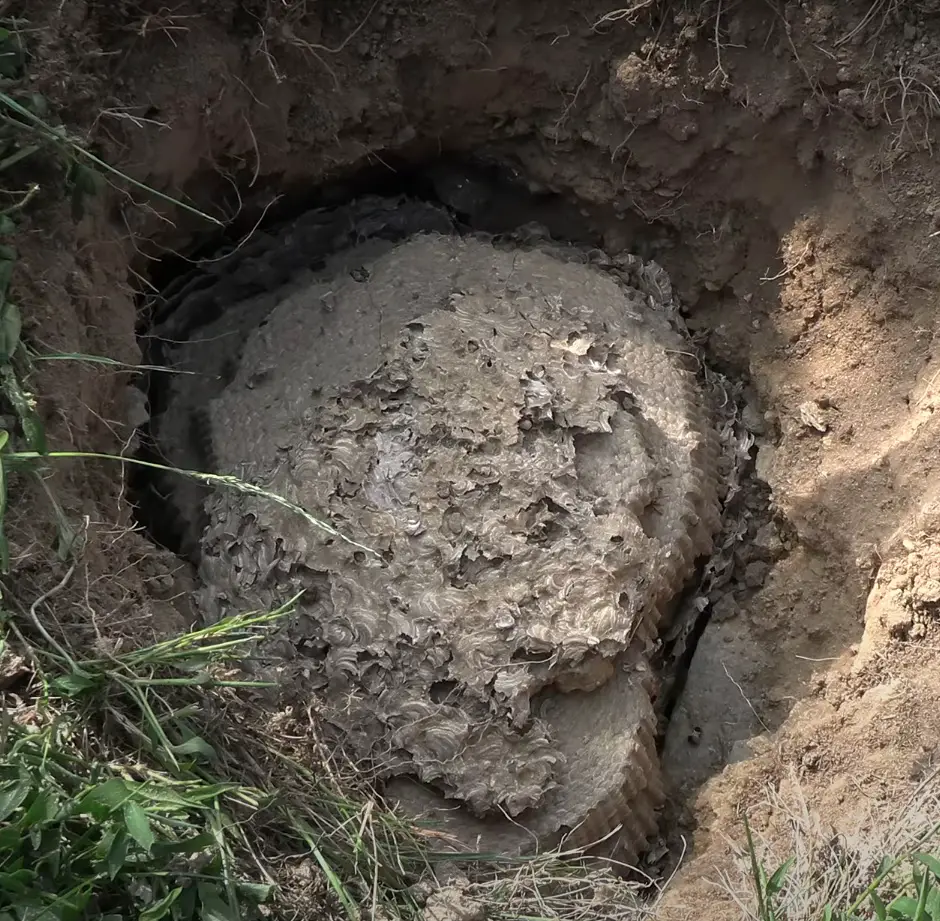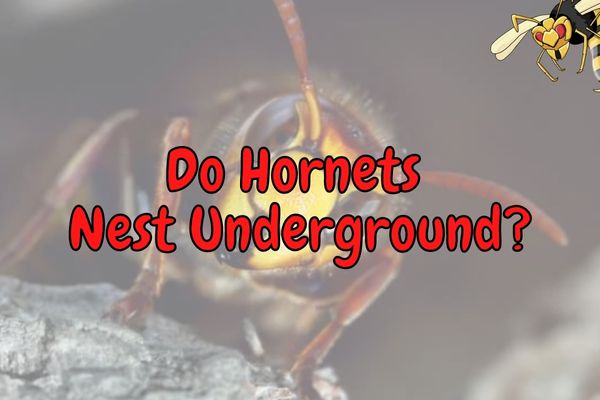Yes, some do. But it is not very common in North America. Instead, the species of wasps that nest underground are most often yellowjackets and some are confused with true hornets.
While the only true hornets of North America (The European Hornets) rarely nest underground, their Asian Giant Hornet cousins prefer underground burrows as their nesting ground. Yellowjackets, which are not true hornets but resemble them a lot, will gladly nest underground throughout the US.
To tell which insect you’re looking at, look at the insect’s coloring and shape. Wasps and yellowjackets are usually more slender and brightly colored. They can be striped or solid red, black or blue. Hornets tend to be rounder and fatter than wasps. They usually are black and yellow striped.
For more information on the types of large wasps and hornets in the US see my recent article on hornet types in North America.
Contents
What type of hornet nests in the ground?
While most large wasps that nest underground in the US are yellowjackets their Asian cousins, the Asian Giant Hornet, prefer to nest underground but will also nest above ground occasionally.
The only type of hornet that burrows in the ground in North America is the cicada killer or sphecius specious hornet that is actually not a true hornet but is classified as a yellowjacket.
The cicada killer is so named because it kills adult cicadas. If you see one, you won’t forget it, as it’s two inches long. It’s usually mostly black with yellow markings. However, despite their frightening size, they aren’t something to fear. They don’t defend their burrows.

If you see one, you won’t have to worry about encountering a swarm of them, as these hornets live solitary lives. Cicada killers dig burrows for their eggs. Once the hornet has killed a cicada, she brings it back to the burrow and lays eggs on it. When the eggs hatch, the larva feed on the cicada.
These hornets usually prefer digging in the sandy ground that’s easy to excavate. Because of this, they are often found in playground areas or golf courses.
Another type of insect called the digger wasp is sometimes confused with a hornet. However, it is much smaller and preys on various insects for its brood. It also lives alone.
There is also the small yellowjacket. Some authorities group them with hornets, others with wasps. These don’t dig burrows but rather take advantage of holes that are already there. The workers build a paper nest inside the holes. These are the kind that will swarm around you when you step on their nest hole or get too close.
Why do hornets make nests in the ground?
It’s not really known why some hornets prefer ground burrows to the nests above ground that their cousins make, but it may not be a stretch to believe that it may have something to do with the fact that they are more protected in areas where it rains little.
Also, as we will see, the new queen is better protected from cold and frost under the insulating soil when she has to hibernate over the winter.
Some species that do may also be largely solitary, living alone instead of in large colonies.
Even the yellow jackets find security underground although they live in a swarm. They are protected there from weather and predators.
How deep are ground hornet nests?
Cicada killers dig burrows about six inches down. They will dig more than one nest at a time, as they don’t lay all their eggs in one.
The Asian Giant Hornet can make its nest a few inches from the surface up to one foot deep. See the video below for an example of an Asian Giant Hornet nest removal!
Since yellow jackets use holes dug by others, they could be fairly deep, as they will even use abandoned burrows created by fairly large animals such as the tunnels of gophers or a groundhogs’ abandoned layers!
When are ground hornets most active?
These insects prefer warmer weather. They are most active on dry days when the temperature is at least 75 degrees.
This means that they are most active during daylight hours. However, on warm evenings they can still be active but are usually quiet at night in colder climates.
This is a boon to the cicada killer, as cicadas usually emerge from the ground to shed their outer shell in the evening, emerging as attractive insects with wings.
They can’t fly until their wings are fully dry, so they are easy to capture.
What happens to ground hornets in the winter?
Wasps of any kind will die off when the weather turns cold, especially when the area starts going below freezing at night.
As the weather gets colder in the fall, the hornets prepare their nest ahead of winter by decreasing the size of their front door to prevent heat loss. But it will not be enough.
Unlike honeybees, hornets do not store supplies to get through winter.
Therefore their colony will not be able to sustain fewer workers. Despite the seasonal change, there are still gruesome jobs to be done. The hornets drag larvae out of their cells and dump them outside the nest to die. New workers are no longer needed.
They will even stop feeding their queen. After bringing forth her new colony, she slowly starves and dies. She lasts barely a year.
A small group of queen larvae still receive food as the only ones.
They are the only ones left in the colony to have a chance to survive as next year’s queens, who will later re-establish their own colony and start the cycle anew.
Usually, only one fertile queen larvae will survive as the last members of a colony. During late fall, they hibernate over the winter to emerge again in spring when they start looking for a suitable place for a nest.
Are ground hornets the same as yellowjackets?
This is a matter of some question, as some authorities label them as wasps while others call them hornets.

However, in the US, the only large wasps that prefer to live underground are yellowjackets such as the bald-faced hornets (I know, the naming is confusing!) as the only true hornet in the US (the European Hornet) usually build its nest in the trees.
Some classify the difference as wasps having their nests above ground while hornets have them below ground.
Most authorities classify the bald-faced hornet as a wasp, but others state that they are hornets, even though they nest above ground.
Are ground hornets dangerous?
The cicada killer certainly looks frightening because of its size, but it isn’t aggressive as some of its relatives are.
Only the female can sting, but she rarely does. She doesn’t defend her nest as some wasps do. You mind your business, and she’ll mind hers. Do take some time to watch her, though, as in many places they are not often seen.
Yellow jackets are another story. They will fly out of their home and attack anyone who gets too close to the hole or steps on it.
How to Get Rid of Ground Hornets
Hornets can be a plague to have in your backyard and they can be dangerous to children and pets too.
And although a pretty hornet’s nest can bring in a significant amount of cash and the hornets can play a somewhat beneficial role in the ecosystem, they are mostly just destructive as they kill honey bees and disrupt natural pollination cycles.
The best way to get rid of hornets is to get rid of their nest, but you can also keep them away for a while without actually dealing with the nest itself.
Insecticide sprays are the preferred solution and come in eco-friendly natural forms as well. However, the synthetic ones are still the most effective ones for killing the hornets and yellow jackets but should be used only outdoors and with care.
Use insecticide sprays
The most effective way to kill hornets in your backyard is by spraying the nest. The best time to apply a hornet killer is at night, when it is dark. Apply the spray at the entrance of the nest and let it stay there for six to eight seconds.
Most sprays can reach up to 20 feet away so you do not have to worry about getting too close to the hornet or yellow jacket nest itself.
You can also make your own insecticide spray using a strong ammonia solution or essential oils mixed with soap and water. These are, however, not as effective as the commercially available sprays, but will work for minor infestations.
While the ammonia spray is effective in killing ground hornets, this solution is best applied after dark. Be sure to cover the mound when you pour the liquid. Repeat the application as needed. Another method is to use essential oils on the mounds.
Natural essential oils can also help to kill and keep hornets away. Essential oils can be mixed with two cups of water in a spray bottle so that you can spray the area where ground hornets are active. If the hornets are breeding in sparse patches, it is recommended to seed those areas with the spray as well.
Ultrasonic repellants
While this strategy will not actually kill the hornets, it will help to keep them away from your house or property. As a bonus, it also helps keep other pests away like mice, rats, mosquitos, as well as gophers and groundhogs (if placed outside).
They work via sounds so high frequency that you cannot hear them, but most insects and pests can! Placing one in your house will make sure that no hornets or wasps establish their nests there.
They also come in solar-powered versions for your backyard to keep hornets and wasps away from certain locations like your vegetable garden.
Use hornet traps
If you want to keep hornets away without using strong synthetic chemicals, there are also a few solutions such as traps or decoys.
Another effective method is to trap the hornets yourself with a homemade trap. You can make a trap out of a plastic 2-liter soda bottle, and place canned cat food or ripe fruit near the nest.
You can also put an empty can or lid near the nest. If you do decide to use a trap, you should keep your pet and other animals away from it as the dead hornets can still sting and are dangerous to touch.
Use nest decoys
You can also hang a paper bag in the back of your yard to keep the hornets away from your house (they will think it’s their nest!).
Also, a good way to prevent hornets from establishing on your property is to keep your yard neat and tidy by trimming back bushes and plants, and don’t place flowers near doors or pathways.
Also, be sure to cover trash cans and keep them closed. If you are allergic to hornets, you may want to hire a professional hornet removal service.
However, always be on the safe side! If you are allergic to wasp stings, you should seek professional help for the nest removal.
If you are not allergic, you can follow these tips to get rid of hornets in your backyard but remember to avoid disrupting the nest too much because it releases pheromones that trigger other wasps to perceive you as a threat.
Conclusion
Hornets’ nests are usually found above the ground, although some species will nest in the ground. However, these species are often large wasps or yellowjackets and are not considered true hornets.
The cicada killer is the only type of hornet that burrows in the ground and is actually a yellow jacket genetically speaking.
These hornets are not aggressive and will only sting if provoked. Yellow jackets are the most dangerous type of hornet and will attack anyone who gets too close to their nest.










